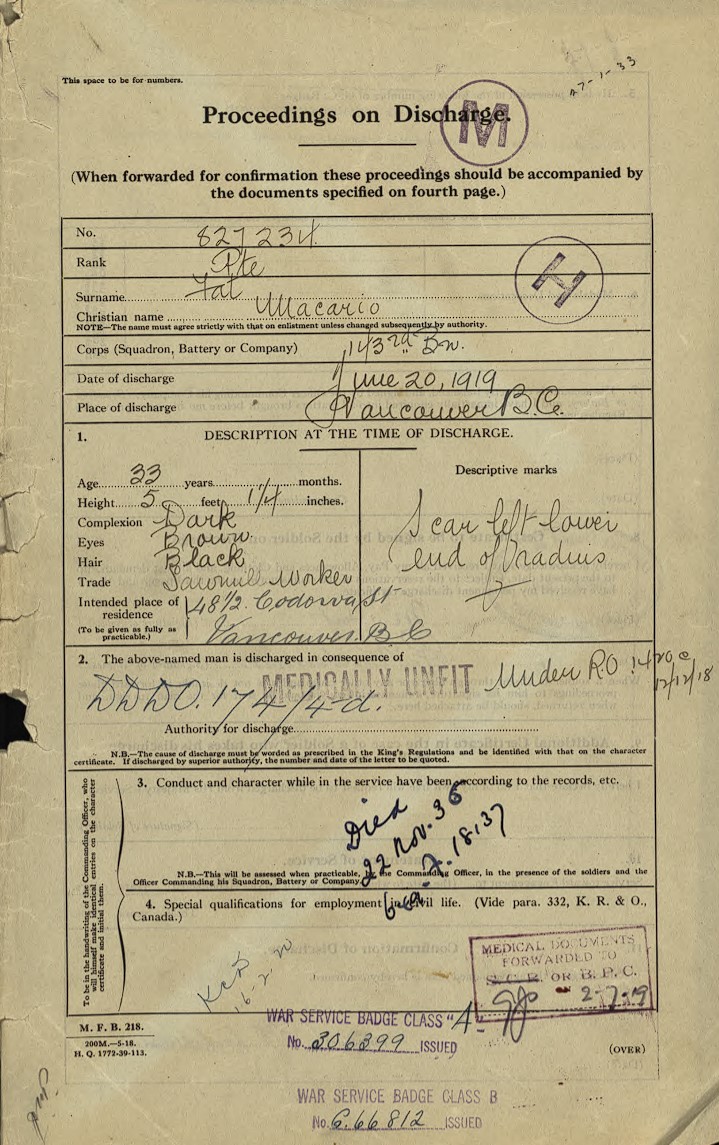Macario Fat, Filipino Canadian war veteran (born 2 January 1886 in Barili, Cebu, the Philippines; died 24 November 1936 in Victoria, BC). Fat was a soldier with the Canadian Expeditionary Force. He was one of the few Filipino or Asian Canadians to be able to serve during the Great War.
Early Life
Macario Fat was born on the island province of Cebu, the Philippines. He was the son of Condino and Remigia Fat. In the late 1800s, the country was still a colony of Spain. Fat likely spoke Spanish — the exclusive language in the islands at the time. He came to Canada in 1904 a few years after the U.S. annexed the Philippines. In Vancouver, he became a sawmill worker. He became a naturalized Canadian three years later.
In 1914, Fat became one of the first directors of the newly established Vancouver Filipino Club. At the time, the Filipino Canadian community was very small in Canada. The social club’s members attended lectures and took part in recreational activities. They also provided support for charity and benevolent purposes. The club had 41 members when it was formed.
Volunteer Recruitment
At the outbreak of the First World War, many non-white people in Canada were excluded by the government from military service. However, when casualties rose overseas, the Canadian Expeditionary Force (CEF) became desperate for volunteers. Two years into the war, the policy on recruiting racial minorities was reversed. As in most cases, enlistment offered recruits an escape from hunger and economic depression. Joining the CEF also brought special privileges and pensions despite the meagre rate of pay.
Fat enlisted in the Canadian Army months before conscription began in 1917. Early that year, he went to the recruitment office in Vancouver to enlist. He was judged physically fit for overseas military service. On his attestation, Fat indicated his occupation as “Fireman.” He mentioned that he was not married. He also had the name of his brother and mother from Cebu as his next-of-kins.

Bantam Battalion
Fat was given the regimental number 827234 when he enlisted with the 143rd Battalion (BC Bantams). Based in Victoria, BC, the military unit was a bantam battalion — units composed of soldiers below the army's minimum regulation height of 5-foot-4-inch (163 cm). His attestation papers noted that he was 5 feet and 1 1/4 inch. Fat was described as having a dark complexion, brown eyes and black hair. The 31-year-old private prepared to march off to war.
On 17 February 1917, Fat left Victoria Harbour on a short ferry ride to Vancouver. He then crossed most of Canada by train to Halifax, NS. From there, he departed Canada aboard the SS Southland. He arrived in Liverpool ten days later. Upon landing, he and the rest of the 143rd Battalion were sent to the Canadian Holding Depot at Purfleet Camp. There, all ranks passed before a medical board. While awaiting deployment, he was admitted to the military hospital because of influenza on 11 March 1917. He was called to duty a couple days after.
Wartime Service
The 143rd Bantam battalion was broken up and reinforced other units. On 23 March 1917, Private Fat was attached to the 24th Reserve Battalion. By May, he was once again transferred, this time to the 1st Reserve Battalion. In June, he joined the CEF’s 47th Battalion (Royal Westminster Regiment) as part of the 4th Canadian Division. Fat was then deployed to France.
Private Fat arrived on the Western Front after the Canadians had successfully captured Vimy Ridge. (See Battle of Vimy Ridge.) Allied forces were also finalizing preparations for another offensive. The summer of 1917 saw Allied forces holding the line before going onto the attack. (See also Trench Warfare.) In mid-October, the Canadian Corps (see Canadian Expeditionary Force) was ordered to attack Passchendaele ridge. (See Canada and the Battle of Passchendaele.) During the fighting, however, Private Fat suffered from shrapnel wounds on his back and his left forearm.
By November, he was evacuated to a military hospital in England for treatment. He had medical tests after showing signs of jaundice. Fat also underwent X-ray for the rheumatism he contracted. From then on, he was in and out of the hospitals in Liverpool and Brighton. He also developed muscle pain and physical weakness, but was overall quite healthy. In late 1918, he was again infected by influenza during the second wave of the Spanish Flu. (See also 1918 Spanish Flu in Canada.) The Seaford Medical Board recommended that he be returned to Canada when the war was over.
Post-War Life
On 11 November 1918, an armistice came into effect ending the First World War. (See also Remembrance Day in Canada.) Two weeks later, Macario Fat returned to Canada. As a serviceman injured in the line of duty, he was first posted to Vancouver’s Shaughnessy Hospital. He was eventually transferred to the Esquimalt Military Convalescent Hospital. He received a rehabilitation program for the weakness he developed in his left knee.

Fat received the War Service Gratuity for two years after he was honourably discharged on 20 June 1919. In honour of his wartime service, he was issued the War Service Badges “Class A” and “Class B.” He was also likely awarded the Victory Medal and the British War Medal.
Having survived the war, Private Macario Fat moved to Victoria. In the 1920s and 1930s, he notably worked as a driver. Several weeks before he turned 50 years old, he had a heart disease that caused his sudden death. He passed away on 24 November 1936. He was interred in Ross Bay Cemetery among the hundreds of First World War graves.

 Share on Facebook
Share on Facebook Share on X
Share on X Share by Email
Share by Email Share on Google Classroom
Share on Google Classroom



